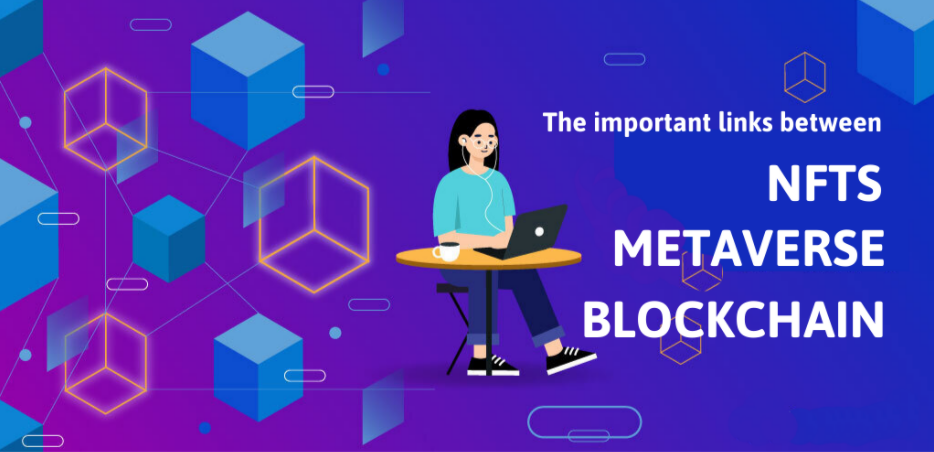If you’ve paid any attention to emerging tech trends over the past year, you will have heard of the 𝐦𝐞𝐭𝐚𝐯𝐞𝐫𝐬𝐞 – a term for connected, virtual worlds that is being described as the next iteration of the internet. You’re probably also aware of blockchain and NFTs (non-fungible tokens) – both of which are hot topics right now.
For anyone that does need a primer – current thinking on the “metaverse” is that it is the term for persistent online worlds, where users can have shared experiences, often through virtual or augmented reality interfaces, allowing for richer immersion than existing online services.
But, as with other game-changing applications of technology – artificial intelligence (AI), for example, or the internet of things (IoT) – the metaverse and blockchain are not concepts that have evolved and exist in isolation. Their true potential will be unlocked when they are applied together. Because the fact is they all have many features and functions that complement each other, enabling them to converge in ways that make them more than the sum of their parts!

Gaming
Gaming will undoubtedly be one of the most exciting use cases for the metaverse, and once again, innovation in this space is being driven by blockchain. The Sandbox is a virtual world where anyone can create their own games and environments and use the Ethereum-based blockchain currency $Sand to buy and sell digital goods and assets. The Sandbox is already home to well-known brands, including Atari and Aardman Animations, creators of Shaun the Sheep.
Crypto gaming is already big business and covers both online casino-style games as well as the more recent gaming paradigm that’s become known as “play-to-earn.” One of the most popular at the moment are Axie Infinity, Pokemon, Oneto11…
If, as everyone from Mark Zuckerberg to tech venture capitalists believe is the case, the 𝐦𝐞𝐭𝐚𝐯𝐞𝐫𝐬𝐞 lives up to its hype, we can expect blockchain gaming to explode in the next few years.
NFTs
According to many predictions, 𝐍𝐅𝐓𝐬 – which stands for Non-fungible tokens and was picked as the word of the year for 2021 by Collins Dictionary – are set to play an important role in the 𝐦𝐞𝐭𝐚𝐯𝐞𝐫𝐬𝐞. Put as simply as possible, 𝐍𝐅𝐓𝐬 are tokens that live on a 𝐛𝐥𝐨𝐜𝐤𝐜𝐡𝐚𝐢𝐧 and can be used to prove ownership of connected digital assets. Primarily we’ve seen them used for trading pieces of digital art, but in theory, they can be connected to anything, including virtual avatars, game assets, and real estate (or should that be unreal estate?)
A key use (quite literally), say some, will be for accessing areas of the 𝐦𝐞𝐭𝐚𝐯𝐞𝐫𝐬𝐞 and proving that someone has the right to control who can or can’t visit or use a particular piece of a virtual environment. Many of the blockchain games that will exist in the metaverse will use NFTs, too, as rewards (as an alternative to the other common type of 𝐛𝐥𝐨𝐜𝐤𝐜𝐡𝐚𝐢𝐧 -dwelling token – cryptocurrencies – which are fungible, and therefore not unique.)
One of the main functions of NFTs within the metaverse will be to assign value to objects. As anything that is digital fundamentally exists only as ones and zeros, it can theoretically be duplicated and distributed an infinite amount of times. 𝐍𝐅𝐓𝐬 provide a framework for attributing value to digital objects because they can be used to prove that someone is the rightful owner of a particular object.
𝐃𝐞𝐜𝐞𝐧𝐭𝐫𝐚𝐥𝐢𝐳𝐚𝐭𝐢𝐨𝐧
It’s important to remember that, as with any predictions about the future, much of this is still speculation – because no one’s exactly sure how the 𝐦𝐞𝐭𝐚𝐯𝐞𝐫𝐬𝐞 will work just yet. People like Mark Zuckerberg have their own ideas, of course, and are throwing a lot of money into making them a reality. But will the reality be a corporate-controlled, centralized 𝐦𝐞𝐭𝐚𝐯𝐞𝐫𝐬𝐞? Or will we end up with something much more decentralized – much like the concept of 𝐛𝐥𝐨𝐜𝐤𝐜𝐡𝐚𝐢𝐧 itself? 𝐁𝐥𝐨𝐜𝐤𝐜𝐡𝐚𝐢𝐧 and its capacity to enable smart contracts and decentralized autonomous organizations (DAOs) offer the possibility of alternate digital realities that aren’t under the ownership of Silicon Valley mega-corporations. They can be “owned” by the people who use them and governed by taking part in secure voting processes and utilizing advanced 𝐛𝐥𝐨𝐜𝐤𝐜𝐡𝐚𝐢𝐧 functions such as staking.
In truth, it’s likely we will end up with something of each – corporations building and maintaining their own metaverses where they make the rules, existing alongside publicly-owned decentralized metaverse. The interesting part will be to see how they play together – will an avatar that’s been born and leveled up in a DAO-driven public metaverse be welcome within the walled garden of Mark Zuckerberg’s private metaverse? Who will have the final say over establishing fundamental principles of society, such as identity or property ownership, within the metaverse? These are important questions, and we can be fairly certain that blockchain will have a crucial part to play in establishing the answer.
𝐁𝐈𝐙𝐕𝐄𝐑𝐒𝐄 – 𝐓𝐡𝐞 𝐌𝐞𝐭𝐚𝐯𝐞𝐫𝐬𝐞 𝐟𝐨𝐫 𝐁𝐮𝐬𝐢𝐧𝐞𝐬𝐬 𝐰𝐢𝐭𝐡 𝐂𝐨𝐧𝐭𝐚𝐜𝐭𝐥𝐞𝐬𝐬 𝐄𝐜𝐨𝐧𝐨𝐦𝐲
𝐵𝑢𝑖𝑙𝑑 – 𝑆ℎ𝑜𝑝𝑝𝑖𝑛𝑔 – 𝑊𝑎𝑡𝑐ℎ – 𝐶𝑜𝑛𝑛𝑒𝑐𝑡 – 𝑆ℎ𝑎𝑟𝑒 – 𝑃𝑙𝑎𝑦 – 𝐸𝑎𝑟𝑛.
